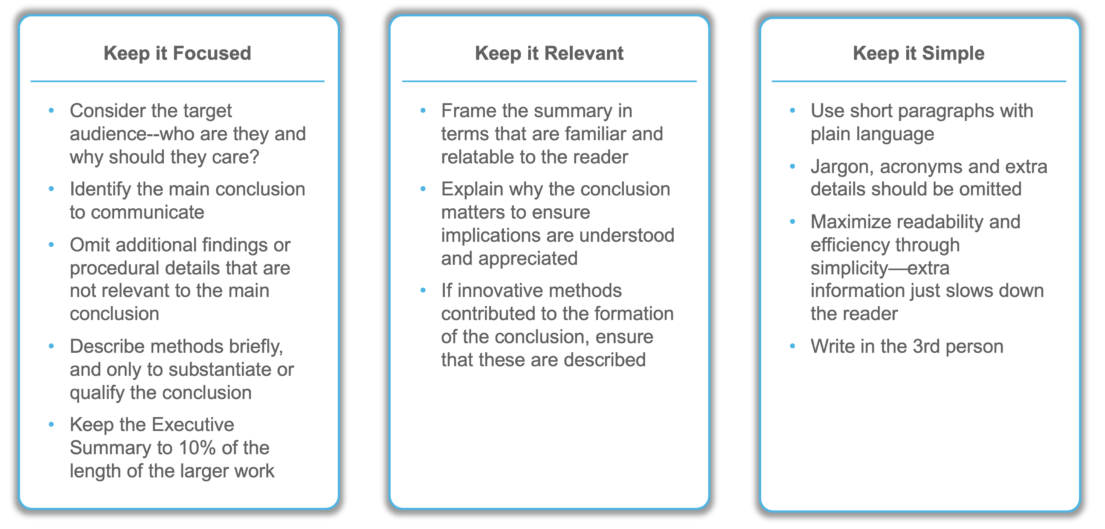by David Wise
November 4, 2020 | How To...
The ability to write an effective Executive Summary is essential to efficiently communicate the critical information of a longer body of work to readers who may want to understand the undiluted key points before investing the time to read the full work. This article addresses how-to write an Executive Summary. The guidelines below offer a general starting point that can be used for most other business writing.
Guiding Principles:
To produce an effective Executive Summary, the author should start by first considering three basic principles “Keep it Focused,” Keep it Relevant” and “Keep it Simple.” By following these principles, the author ensures that the Executive Summary communicates the most important conclusions in a manner that resonates with the reader and is easy to understand.

Executive Summary Structure:
The basic flow of the Executive Summary can be broken into five sections as noted below. However, if the work being summarized is very long, the author may instead wish to have the summary mirror the flow of the document it is summarizing—this can aid the reader with navigating the full document.

|
1.) |
Purpose (explaining the reason for writing; is there an ask, is this to inform, are you asking for a decision)
“Project X has been underway for eight months and is nearly 70% complete. However, the most recent business results clearly indicate that key assumptions used when scoping Project X were incorrect. As a result, Project X will not deliver the promised efficiency benefits without an additional $Z investment.”
|
|
2.) |
Brief Description of Analysis and Methods
“The original benefit analysis for Project X was based on the company strategic forecast and trends exhibited in the company’s results over the prior two years. Upon recognizing the shift in the last quarter’s results, the Project X team reviewed competitor public filings as well as industry publications—all showing similar results and indicate a long-term shift versus the original forecast.”
|
|
3.) |
Describe the Results
“When determining the scope and benefits of Project X, the stakeholders anticipated 10% annual demand growth for Process A that was modeled to continue for 3 years. However, new results show that the shift in behavior has reversed the growth expectations for Process A (now expecting a 3% annual demand decline). Additionally, the shift has led to a corresponding 20% expected annual demand growth for Process B.”
|
|
4.) |
Describe the Implication
“Project X is at a cross roads. It has consumed 70% of its $Y budget. If it runs to completion, it will only deliver 20% of the value that was originally expected. Alternatively, Project X could be cancelled (to recover the unspent budget) or its scope could be increased to include Process B. Inclusion of Process B in scope would require an additional $Z but would double this amount in savings within three years.”
|
|
5.) |
Provide a Call to Action in the Conclusion:
“The Project X team is requesting that the Executive Steering Committee consider the options to continue, cancel or change the scope of the project. The project team believes that cancellation or scope change to be the two best options, but this needs to be evaluated based on the Executive Steering Committee’s confidence in the new forecasts. The project team is requesting a decision on the direction by the next committee meeting on MM/DD/YYYY.”
|
Conclusion
Crafting a succinct Executive Summary is an essential tool for business communication. By following the principles and structure outlined above, the author will ensure that the most important conclusions and implications are relevant and accessible to readers.
For more information on how Lake Shore Associates can help you drive your next transformation, visit www.lakeshore.is.






